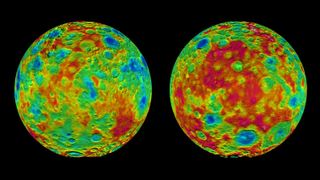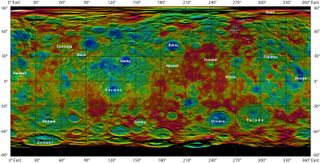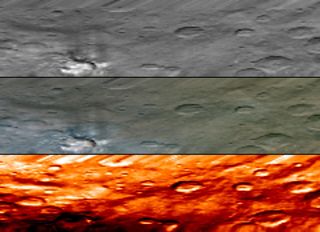Dwarf Planet Ceres' Mountains and Craters Get Names in NASA Maps
Colorful new maps of the dwarf planet Ceres reveal its dramatic mountains and deep craters, now with official new names.
The new Ceres maps were created using data from NASA's Dawn spacecraft, which has been orbiting the dwarf planet since March. While some locations on Ceres once carried labels like "Spot 1" and "pyramid-shaped mountain," they now possess official names like Dantu, Ezina, Haulani and Kerwan. Then there's Occator, the home of Ceres' mysterious bright spots, which seem to fill the Occator crater with a gaseous haze.

All of the new features are named for agriculture spirits and gods, and the new names were recently approved by the International Astronomical Union. Ceres itself is named for the Roman goddess of agriculture. [Watch Ceres Turn in Video Map by Dawn]
Dawn's new topographic maps of Ceres reveal a varied landscape of the features, whose highest highs rise up to 9 miles (15 kilometers) above the dwarf planet's lowest lows."The craters we find on Ceres, in terms of their depth and diameter, are very similar to what we see on Dione and Tethys, two icy satellites of Saturn that are about the same size and density as Ceres," Dawn science team member Paul Schenk said in a statement. Schenk is a geologist at the Lunar and Planetary Institute in Houston. "The features are pretty consistent with an ice-rich crust."

Here's a tour of Ceres' newly named locales:
Occator: The crater with Ceres' mysterious bright spots is 60 miles (90 km) across and 2 miles (4 km) deep. It is named for the Roman god of harrowing, which is a method of levelling soil. New researchhas revealed that the bright spots of Occator release gas to the surface, creating a localized atmosphere within the crater.
Haulani: Also known as "Spot 1," Haulani is a small, bright crater that's 20 miles (30 km) across. It's named after a Hawaiian plant goddess, and seems to be colder than the surrounding area.
Get the Space.com Newsletter
Breaking space news, the latest updates on rocket launches, skywatching events and more!
Urvara: Far south of Occator, Urvara is around 100 miles (160 km) across and 3 miles (6 km) deep. It boasts a 2-mile-high (3 km) pointy peak rising out of the center, and is named for the Indian and Iranian god of plants and fields.
Dantu and Ezinu: These craters are around 75 miles (120 km) across and 3 miles (5 km) deep. Dantu is named for the Ghanaian god associated with planting corn, and Ezinu takes for the Sumerian grain goddess.
Kerwan and Yalode: Each over twice as big as Dantu or Ezinu, these craters are named for the Hopi spirit of sprouting maize and an African Dahomey goddess worshipped for the harvest.
"The impact craters Dantu and Ezinu are extremely deep, while the much larger impact basins Kerwan and Yalode exhibit much shallower depth, indicating increasing ice mobility with crater size and age," Ralf Jaumann, a Dawn science team member at the German Aerospace Center in Berlin, said in the statement.

Ceres itself is the largest object in the asteroid belt and the first dwarf planet ever visited by spacecraft; Dawn arrived in March after exploring the asteroid Vesta. Ceres is around 40 percent the size of Pluto, the second dwarf planet visited by humans, during the New Horizons flyby this month.
The Dawn spacecraft approaches its third science orbit of Ceres in August, where it will skim just 900 miles (1,500 km) above the dwarf planet's surface. Flying three times closer than ever before, the probe will be able to pick up even more detail about the newly named highs and lows.
Email Sarah Lewin at slewin@space.com or follow her @SarahExplains. Follow us @Spacedotcom, Facebook and Google+. Original article on Space.com.
Join our Space Forums to keep talking space on the latest missions, night sky and more! And if you have a news tip, correction or comment, let us know at: community@space.com.

Sarah Lewin started writing for Space.com in June of 2015 as a Staff Writer and became Associate Editor in 2019 . Her work has been featured by Scientific American, IEEE Spectrum, Quanta Magazine, Wired, The Scientist, Science Friday and WGBH's Inside NOVA. Sarah has an MA from NYU's Science, Health and Environmental Reporting Program and an AB in mathematics from Brown University. When not writing, reading or thinking about space, Sarah enjoys musical theatre and mathematical papercraft. She is currently Assistant News Editor at Scientific American. You can follow her on Twitter @SarahExplains.










